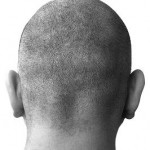Androgenic Alopecia, (Male Pattern Baldness) is not indicator of prostate cancer.
 Androgenic Alopecia has been thought to may be associated with possible connection to prostate growth (bph and prostate cancer. This correlation is derived from the basis of hair loss research that was discovered during the finasteride (Propecia) discovery and research years, and the role of dihydrotestosterone (DHT) to hair loss.
Androgenic Alopecia has been thought to may be associated with possible connection to prostate growth (bph and prostate cancer. This correlation is derived from the basis of hair loss research that was discovered during the finasteride (Propecia) discovery and research years, and the role of dihydrotestosterone (DHT) to hair loss.
Finasteride blocks the receptor for DHT and was found to help benign prostate hyperplasia, and as a side effect keep patients hair.
A new study published in December 2010 from The Department of Epidemiology, Biostatistics and HTA, at Radboud University Nijmegen Medical Centre in The Netherlands found no positive correlation in a patients androgenic alopecia and their risk of hair loss.
Because BPH does not progress into Prostate cancer the study seems to confirm any questions of androgenic alopecia maybe being related to Prostate Cancer, but that is not the case.
The study based on the premise that androgens are assumed to play a central role in the pathophysiology of both prostate cancer (PC) and androgenic alopecia (AA). A correlation between the two phenotypes may be relevant for identification of men at high risk of PC.
The researchers evaluated the association between AA at different ages and PC in a large case-control study.
The case group comprised 938 PC patients recruited from a population-based cancer registry. The controls (n = 2160) were a random sample of the male general population. All subjects completed a questionnaire on risk factors for cancer, including questions on hair pattern at different ages using an adapted version of the Hamilton-Norwood scale, race and family history of PC. Odds ratios (ORs) and 95% confidence intervals (CIs) were calculated using multivariable logistic regression.
The researchers found that baldness at early age appeared to be associated with a lower risk of PC (baldness at age 20: OR = 0.86; 95% CI 0.69-1.07 and baldness at age 40: OR = 0.81; 95% CI 0.70-0.96). Baldness at completion of the questionnaire was not associated with PC: OR = 1.10; 95% CI 0.89-1.34. An isolated ‘frontal baldness’ or ‘vertex baldness’ pattern was not significantly associated with PC at any age. Presence of a combined ‘frontal and vertex’ baldness pattern at age 40 was associated with a decreased risk of PC (OR = 0.62; 95% CI 0.45-0.86). There were no significant associations between AA and aggressive PC.
The research team did not find consistent positive associations between AA at different ages and PC. Link to study info here
Most surprising to us and the researchers was that, if anything, baldness at early age is inversely related to Prostate Cancer in this study.
So there you have it: Androgenic alopecia (male pattern baldness) is not useful as an indicator of men at high risk of Prostate Cancer.